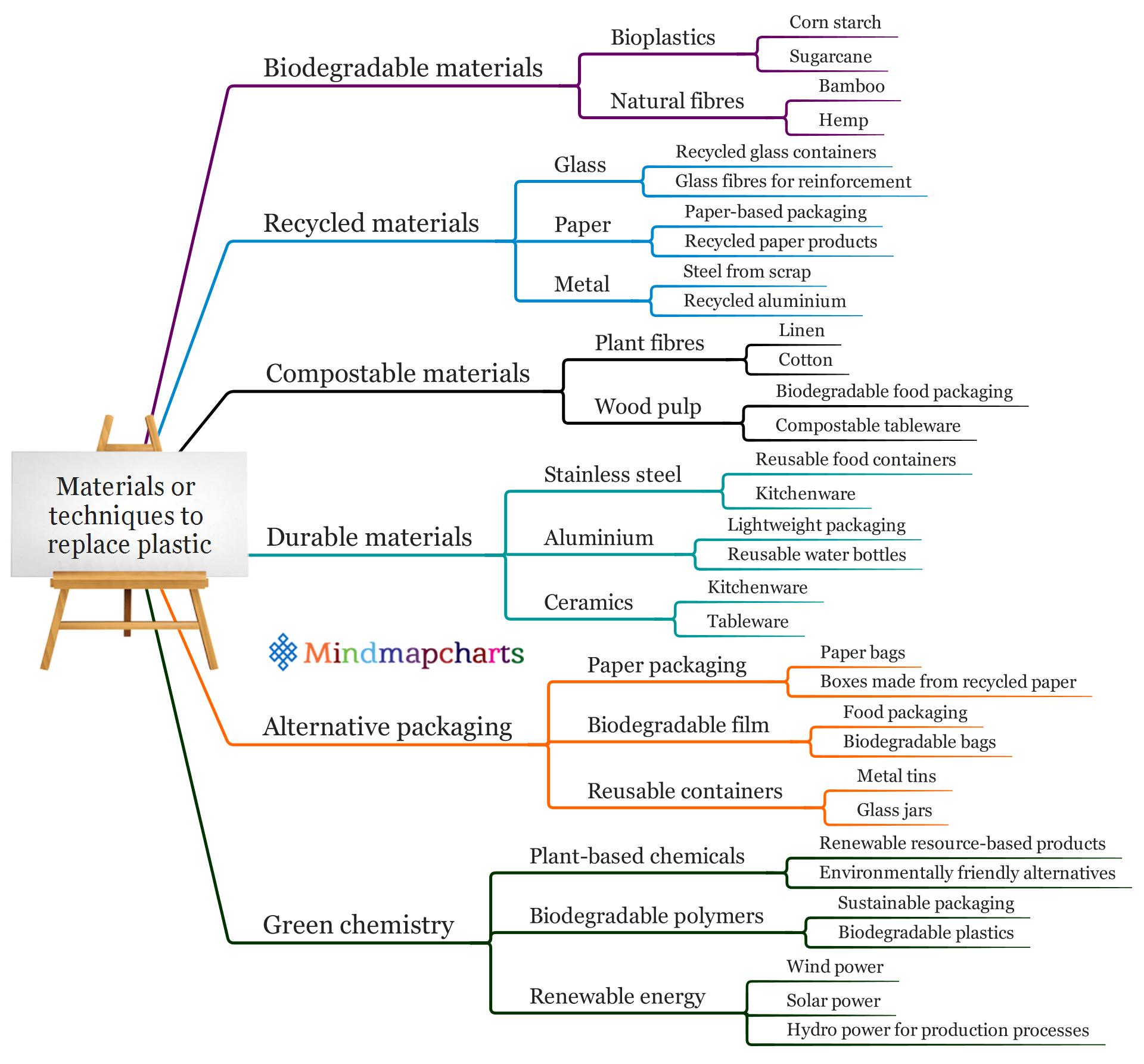Materials or techniques to replace plastic Mindmap
Why we need to find new materials and techniques to replace plastic?
Sustainability: Many alternative materials are made from renewable resources and are biodegradable, reducing their environmental impact. Bioplastics and other materials made from renewable resources, such as corn starch or sugar cane, have a lower carbon footprint compared to traditional petroleum-based plastics. When biodegradable plastics are disposed of, they can break down into natural substances, reducing the amount of waste in landfills. This helps to preserve natural resources and reduce greenhouse gas emissions associated with the production and disposal of plastic.
Recyclability: Many alternatives are highly recyclable, reducing waste and preserving natural resources. Alternative materials such as metal, glass, and paper are highly recyclable and can be used repeatedly, reducing the need for new raw materials and minimizing waste. For example, aluminum cans are infinitely recyclable and can be melted down and re-used repeatedly without any loss of quality.
Health and Safety: Some alternatives are made from non-toxic or less harmful materials, reducing the risk of harm to human health and the environment. For example, paper-based packaging and glass containers are free from harmful chemicals, making them safer for food packaging compared to traditional plastic containers.
Renewable Energy: Some alternative materials are produced using renewable energy sources, such as wind, solar, or hydro power, reducing the carbon footprint associated with their production. This helps to reduce greenhouse gas emissions and contributes to a more sustainable future.
Reduced Plastic Waste: By reducing the use of plastic, the amount of plastic waste in the environment is reduced. Plastic waste can cause significant harm to wildlife, marine life, and the environment, so reducing its use can help to protect these vulnerable ecosystems.
Cost-effectiveness: Some alternative materials, such as paper-based packaging, can be produced at a lower cost compared to traditional plastic packaging. This can result in cost savings for consumers and businesses, making it a more cost-effective solution in the long run.
Durability: Some alternatives, such as metal containers and biodegradable composites, are stronger and more durable than plastic. This reduces the need for frequent replacement and the associated waste, providing a more sustainable solution in the long run.
Versatility: Some alternative materials, such as bamboo composites and biodegradable polymers, can be used in a wide range of applications, making it easier to replace plastic in various products. This versatility makes it possible to reduce the use of plastic in a wide range of products, from clothing and textiles to packaging and insulation materials.
Here's some alternative materials and methods to replace plastic usage:
- Bioplastics: made from renewable resources such as corn starch, sugar cane, or potato starch, they can be composted or easily biodegraded.
- Cellulose: derived from wood pulp, it is biodegradable and can be used as a substitute for plastic in packaging, food containers, and other products.
- Paper-based packaging: made from paper and other natural materials, it can replace plastic in a wide range of applications, from food packaging to shipping boxes.
- Metal packaging: made from aluminum and steel, it is recyclable and can replace plastic in various applications, including beverage cans and food containers.
- Glass: a highly recyclable material, it can replace plastic in various applications, including food containers and personal care products.
- Natural fibers: such as cotton, hemp, and flax can be used as an alternative to plastic in products like clothing and textiles.
- Mushroom packaging: a new innovative material made from mycelium, the root structure of mushrooms, it is compostable and can replace plastic in packaging and insulation.
- Biodegradable polymers: synthetic materials designed to break down into harmless substances after a certain period of time, they can replace traditional plastic in various applications.
- Recycled materials: using recycled plastic, glass, paper, and other materials to produce new products reduces the need for new materials and reduces waste.
- Reusable packaging: using reusable containers, bags, and other items instead of single-use plastic can significantly reduce plastic waste.
- Bio-based composites: made from plant-based materials such as bamboo, they can replace plastic in products like furniture and building materials.
- 3D Printing: using biodegradable and recycled materials to produce products on-demand, reducing the need for large quantities of plastic to be produced and stored.


